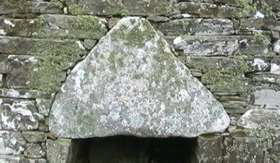|
This Section: In the beginning The Celts The Romans Crossword-so far Hadrians Wall Antonine Wall Pictish Society The Wall and the Picts Timeline so far The next 450 years: A.D. 350 - A.D. 794 A.D. 795 - A.D. 1260 A.D. 1260 to History Main Page Home Page |
As stated previously the Romans brought a certain amount of order to Scotland (as it is now called). They classified some fifteen tribes in the North and loosely identified the territories they occupied. In addition they also observed that tribal chiefs had a religious as well as a royal function. Surprisingly (as we believe girl power is a modern phenomenon) women could have such a role, as with the case with Boudicca of the Iceni. The succession of leaders was matrilineal: it mattered more who their mother was than who their father was and as it is possible that women may indeed have more than one husband, the matter of succession to be complex. This perpetuated the myth, that later romantics enhanced, that Pictish society was democratic, but it was in fact full of social different nations.
Under the tribal leader there was a class who maintained Chariots and fought from them. These charioteers had the status of Baron's, owned cattle and land in their own right and usually they owned slaves who worked their land and sea are in their homes. The slaves would normally be prisoners of war, although their status was often hereditary (i.e. born into slavery). There may also have been raids to obtain slaves from other tribes and vulnerable coastal communities.Between the ranks of barons and slaves were the freeholders, who owned shares in the common land of each tribal group.
One of the distinctive features of the new settlers, was the distinctive dwelling houses that they erected. Built on the model of the old roundhouses it was built of stone and rose high above the ground, but the entrance was often on the upper level. This was the broch  An example of the brochlintel of which many examples remain in the Northern Islands of present day Scotland.
Language also again became more distinct with tribes merging or being wiped out by their neighbours. By the fourth century it is believed that Celtic speech was the main language of the whole of the Northern region.
Whilst many of the elements of civilisation were coming to the fore, it was still troubled times and in the late third century fighting once again broke out. |
|
|
|